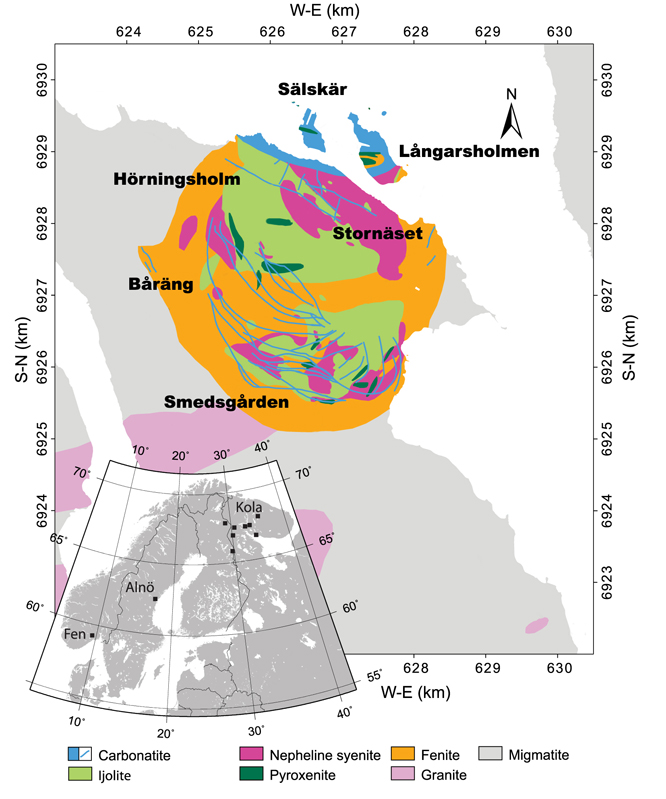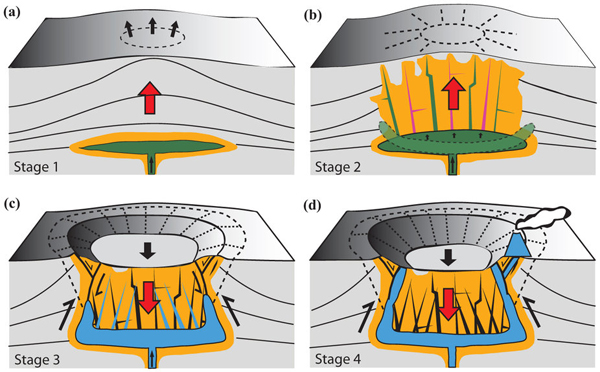The Alnö complex
The Alnö ring-complex in central Sweden is one of the largest carbonatite and alkaline ring-type intrusions in the world with an approximate radius of 2.5 km. The Alnö complex was emplaced into Palaeoproterozoic migmatitic country rock. It is one of the less than 500 documented alkaline-carbonatite and carbonatite intrusions and it is one of the largest carbonatite ring-complexes; In addition, Alnö makes a rare case due to its intrusive-extrusive carbonatite association (carbonate-cemented vent-breccias with accretionary lapilli provide evidence for associated volcanic activity).The main portion of the Alnö igneous complex contains a suite of alkaline silicate rocks (ijolite, nepheline-syenite, and pyroxenite) and various carbonatite and silicate-carbonatite dykes (sövites and silico-sövites respectively) that crop out in a semi-circular pattern. Alnöite, a mafic alkaline silicate rock that belongs to the kimberlite family and is melilite-rich, has been named after the island.
The Alnö complex (Fig.3) consists of five separate small intrusions: the Smedsgården intrusion is the main intrusion in the complex and it is surrounded by the Båräng, Hörningsholm, Långarsholmen and the Stornäset intrusions.
The main intrusion contains a suite of alkaline silicate rocks (ijolite, nepheline-syenite, and pyroxenite) and various carbonatite and silicate-carbonatite dykes (sövites and silico-sövites respectively) that crop out in a semi-circular pattern. Alnöte, a mafic alkaline silicate rock that belongs to the kimberlite family and is melilite-rich, has been named after the island.
The carbonatite dykes have been divided into two groups with respect to their size and dip direction. The longer and thicker dykes are restricted tothe southern part of the intrusion and generally dip outward from the centre, whereas shorter and thinner dykes dip dominantly inward towards the centre of the complex. A suite of radial dykes is present as well, which from field mapping is thought to be the oldest group of dykes. Later alnöitic, phonolitic and syenitic dykes also occur.
A halo of fenite that surrounds the Southern intrusion resulted from metasomatic alteration of the wall rock by CO2-rich fluids from the intruding carbonatites and alkaline silicate rocks. The fenite’s degree of alteration varies with distance from the intrusion. An unaltered variety of migmatite, approximately 500 m from the intrusion, gives way to a strongly fenitised variety with no free quartz in close proximity to the intrusion.

Fig.3: Geological map of the Alnö ring-complex. Inset map of northern Europe shows the locations of Alnö in central Sweden, the coeval Fen complex in Norway, and the alkaline and carbonatite intrusions in Kola, Russia. From Andersson, M. (2015).
Alkaline silicate rocks of the complex
• Melilitolite and other melilite-bearing rocks:
Melilite-bearing rocks occur both on the mainland north of Alnö Island and within the main complex on the island. On the island, the melilite-bearing rocks occur as dykes and are alnöites and kimberlitic alnöites, which intruded after the main intrusive phase of ijolite, nepheline syenite and carbonatite magmatism. Kimberlitic varieties of alnöites have been described both from the mainland north of Alnö Island and from the area southwest of Hörningsholm; These are slightly more primitive than alnöite proper as shown by a high content of olivine and the occurrence of rounded enclaves of mantle-derived rocks composed of olivine, diopside, chromite and phlogopite.
• Pyroxenite, ijolite and nepheline syenite:
Four series of alkaline silicate rocks and carbonatites have been recognized in the complex on Alnö Island. The following order of intrusion has been established based on field relations: pyroxenite/ijolite → nepheline syenite → carbonatite. The relationship between the pyroxenite and the ijolite (the name is here used collectively for clinopyroxene-nepheline rocks) is somewhat ambiguous although a majority of the pyroxenites appear to be cumulates formed in the same magma that subsequently crystallized ijolite. Layering with gradational relationships between these rocks can be observed at several localities at Alnö, but pyroxenite is also found as fragments included in and sometimes cut by ijolite.
The ijolite series rocks areally dominate the intrusion; these rocks display such variation of textures and structures indicating that they might be derived from several batches of magma.
The nepheline syenites occur as plugs with diameters up to several hundred meters, as well as small bodies, sheets and dykes clearly cross-cutting the ijolite series rocks. Texturally, the nepheline syenites are also variable and three types can be distinguished on the basis of textural and field appearance. These are normal nepheline syenite, pegmatitic nepheline syenite and micro nepheline syenite. Normal nepheline syenite is texturally homogenous and intrudes prior to the micro- and pegmatitic varieties. It is also the most common of the three types; micro nepheline syenite has been observed at three localities and the pegmatitic variety occurs sporadically in the southern part of the main intrusion (Smedsgården).
• Carbonatites:
The carbonatites within the main intrusion on Alnö Island are mainly Ca-carbonatites with only minor Mg-carbonatite. They are intruded as dykes with widths from several tens of meters to only a few centimeters and cross-cut all major igneous rocks of the main intrusion, i.e. pyroxenite, ijolite series rocks and nepheline syenite.
It has not been possible to establish if there are different generations of Ca-carbonatites within the Alnö complex. Most Ca-carbonatite appears to have been intruded at more or less the same time as no cross-cutting relationships have been observed. However, it has been observed that Mg-rich carbonatites, which only occur as smaller dykes (< 50 cm in width), in general cross-cut the Ca-carbonatite dykes. Silicate minerals are ubiquitous in Ca-carbonatite. These are primarily clinopyroxene (diopside-aegirineaugite), phlogopite and titanite, but olivine, alkali feldspars, wollastonite and quartz have also been observed. It should be noted however, that some of the silicate minerals present in the Ca-carbonatites are derived from surrounding wall-rock and thus did not crystallize within the carbonatite magma.
Emplacement model
Based on these data and the available surface geological studies (Kresten 1980) a multi-stage model for the emplacement of the Alnö complex was proposed (Fig.4). In stage one (Fig.4a), a low-viscosity silicate magma rich in CaCO3 ascends and gets trapped at about 4-5 km depth. It forms a laterally extensive sill-shaped magma chamber. This process initiates an up-doming structure and surface bulging forms early radial dykes.
In stage two (Fig.4b), growth and inflation of the magma chamber increase the uplift of the overburden. Radial dykes and increasingly inward dipping cone-sheets intrude into the countryrock above the chamber. In stage three (Fig.4c), magma, now with a significant carbonatite fraction present, evacuates from the magma chamber via dykes leading to a pressure drop in the intrusion. This causes the central part of the overburden, or roof, to subside. In stage four (Fig.4dFig.2d), concentric outward dipping fractures form and intrude to make ring-dykes during progressive subsidence of the central block/roof during caldera collapse.

Fig.4: Schematic model suggesting the emplacement of the Alnö complex. From Andersson, M. (2015).
.jpg)
Alnöite: Gold-brown phlogopite crystals. Alnö complex. From Hildegard Wilske
.jpg)
Alnöite: Gold-brown phlogopite crystals. Alnö complex. From Hildegard Wilske
.jpg)
Ijolite: alkali feldspar (pink), pyroxene (dark) and nepheline (grey). Alnö complex. From Hildegard Wilske
.jpg)
Ijolite: alkali feldspar (pink) and pyroxene (dark). Alnö complex. From Hildegard Wilske
.jpg)
Pegmatitic ijolite: alkali feldspar (pink), nepheline (grey) and pyroxene (dark). Alnö complex. From Hildegard Wilske
.jpg)
Pegmatitic ijolite: alkali feldspar (pink), nepheline (grey) and pyroxene (dark). Alnö complex. From Hildegard Wilske
.jpg)
Jacupirangite (pyroxenite): pyroxene (dark) and nepheline (grey). Alnö complex. From Hildegard Wilske
.jpg)
Jacupirangite (pyroxenite): pyroxene (dark) and nepheline (grey). Alnö complex. From Hildegard Wilske
.jpg)
Sövite (carbonatite): apatite (pink), phlogopite (dark) and calcite (white). Alnö complex. From Hildegard Wilske
.jpg)
Sövite (carbonatite): apatite (pink), phlogopite (dark) and calcite (white). Alnö complex. From Hildegard Wilske
.jpg)
Sövite (carbonatite): phlogopite (dark) and calcite (white). Alnö complex. From Hildegard Wilske
.jpg)
Sövite (carbonatite): phlogopite (dark) and calcite (white). Alnö complex. From Hildegard Wilske
.jpg)
Sövite (carbonatite): pyroxene (balck) and calcite (white). Alnö complex. From Hildegard Wilske
Bibliography
• Andersson, M. (2015). 3D Structure and Emplacement of the Alnö Alkaline and Carbonatite Complex, Sweden: Integrated Geophysical and Physical Property Investigations.
• Kresten P (1980): The Alnö complex: tectonics of dyke emplacement. Lithos 13:153–158.
• Brueckner H.K, Rex DC (1980): K-A and Rb-Sr geochronology and Sr isotopic study of the Alnö alkaline complex , northeastern Sweden. Lithos 13:111–119.

